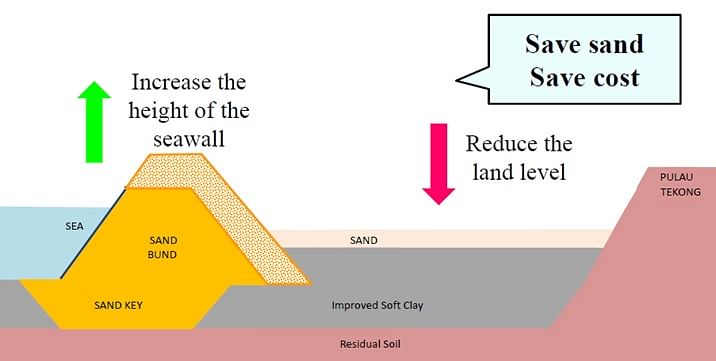Pulau Tekong to get extra land the size of two Toa Payoh towns using new reclamation method
Sign up now: Get ST's newsletters delivered to your inbox
Yeo Sam Jo
Follow topic:
SINGAPORE - A new method of land reclamation will be adopted at the north-western tip of Pulau Tekong, adding new land the size of two Toa Payoh towns for military training purposes, National Development Minister Lawrence Wong said on Wednesday (Nov 16).
The empoldering method involves building a dike around the area to be reclaimed and draining water from it, creating a low-lying tract of land below sea level, called a polder. The polder is buffered from the sea by a dike, and water levels in the polder are controlled by drains and pumps.
The dike will measure 10km long, up to 15m wide at its crest and stand about 6m above sea level.

Compared to the traditional method of infilling with sand, this will reduce the amount of sand needed for reclamation and save on upfront construction costs, said the Housing Board, which is the agent appointed by the Ministry of National Development to carry out land reclamation works on behalf of the Government.
To ensure that the project is cost-effective, safe and environmentally sensitive, the HDB said it is working closely with Professor Kees d'Angremond from the Netherlands - an authority on polder development and longtime adviser to Singapore on reclamation.
While polders may be new to Singapore, Professor d'Angremond said they have been built in the Netherlands for the past 2,000 years.
These polders were primitive ones built by farmers who wanted to protect their land against flooding, he said.
Safety of the polders is ensured through methods such as the building of strong dikes, determining the height of the dike in relation to expected sea levels and wave action, as well as having a grass cover on the inner dike slope to ensure it does not erode, Professor d'Angremond said.
"As Dutchmen we are convinced that it is a good solution for the future, but I think it is very wise that your Government has decided to call it a pilot polder and to do quite a lot of testing on the polder before you decide to apply the method in other places."
"That means also that we will do a lot of research in polders together to see whether we can make further improvements that are really dedicated to the conditions in Singapore."
The HDB will call for a tender by the end of this year and construction will commence at the end of 2017. The reclamation project is slated for completion in 2022.
Mindef will maintain the 810ha polder land upon its completion, while the drainage system, dike, water pumping stations and canals will be maintained by national water agency PUB.
The reclaimed area on the island will also have 21km of roads - the combined length of East Coast Parkway - and 29km of drains.

The HDB said an environmental study has been carried out to ensure that there will not be any significant impact on the surrounding marine environment and marine life.
"The study has found that the environmental impact due to the development of the polder would be minimal," said the HDB.
It added that surrounding areas with mangroves and other plant life will be conserved and protected.
Mr Wong told reporters during a site visit on Wednesday that Singapore has been studying the empoldering method for some time to reduce its reliance on sand for reclamation purposes.
"The polder project is important also for another reason, which is that it helps us to build capabilities," he said.
"Because in the long term, we know that we are facing the threat of climate change, sea levels rising, and we are low-lying in Singapore. So with this project, I think that the experience that we gain in learning how to build dikes, in learning how to manage coastal areas, this will be very important for us as we deal with the threat of climate change in the longer term.
"So this is really a project not just about expanding our physical space but also about building up capabilities and making ourselves a more resilient nation in the longer term."
He said he will not rule out adopting empoldering for future reclamation projects, and also cited challenges such as the disruption in sand supply as a good reason to adopt the method.
The method will lead to a "significant amount" of savings in sand and cost, Mr Wong said, but did not reveal any figures.
"But we do expect significant savings in sand and also in construction costs," he said.
When asked why Pulau Tekong needs more land, he said that the country is "always in need of more land".
"For this particular expansion, it's going to be used for Singapore Armed Forces (SAF) training. But the needs for land continue to grow, whether it's for military, for housing, for commercial uses," he said.
"We are always looking at options to expand. And by expanding Tekong, providing SAF more space for their training needs, which are growing, we can free up land in the main Singapore island for other developmental purposes," he added.


